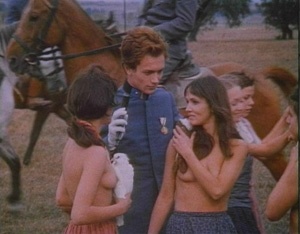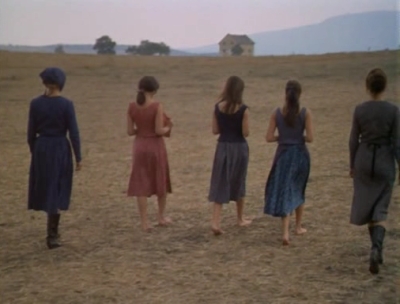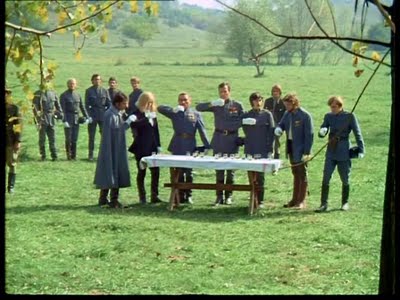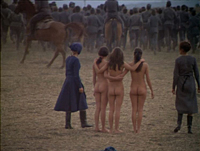This was written in the summer of 2000 for a coffee-table book edited by Geoff Andrew that was published the following year, Film: The Critics’ Choice (New York: Billboard Books). — J.R.
A recent documentary about communist musicals called East Side Story (Dana Ranga, 1997) assumes that communist-bloc directors were just itching to make Hollywood extravaganzas and invariably wound up looking strained, square, and ill-equipped. But Red Psalm (1971), Miklós Jancsó’s dazzling, open-air revolutionary pageant, is a highly sensual communist musical that employs occasional nudity as lyrically as the singing, dancing, and nature. That is to say, within its own specially and exuberantly defined idioms, it swings as well as wails.
Set near the end of the 19th century, when a group of peasants have demanded basic rights from a landowner and soldiers arrive on horseback to quell the uprising, Red Psalm is composed of only 26 shots. (With a running time of 84 minutes, this adds up to an average of three minutes per shot. Jancsó’s earlier feature from 1969, Winter Sirocco, is said to consist of only 13 shots.) Each long take is an intricate choreography of panning camera, landscape, and clustered bodies that constantly traverse, join, and/or divide the separate groups. The music, ranging from revolutionary folk songs to “Charlie Is My Darling,” will keep playing in your head for days, and the colors are ravishing. The picture won Jancsó a best director prize at Cannes, and it may well be the greatest Hungarian film of the 60s and 70s, summing up an entire strain in his work that lamentably has been forgotten in more recent years.
The film’s original Hungarian title, Még Kér a Nép, is said to translate into English as “And the People Still Ask”. This suggests that that charge of formalism frequently leveled against Jancsó may stem in part from an inability to fully comprehend his historical and political meanings — combined with an understandable temptation to become intoxicated by the stylistic virtuosity of the externded takes and intricately plotted camera movements, thereby overlooking what the film’s images actually mean. According to Hungarian film theorist Yvette Biró, who used to write scripts for Jancsó, “bleeding white doves, a white shirt pierced through by a dagger, a long lingering shot of a gun tied with a red ribbon,” are all “taken from the folklore of our collective memory….Symbols here are elements of a folk community’s language. Through a dance, Jancsó brings back to life this community, whose fate, in the fairy tale we are presented, is determined by ancient, biblical, and folkloristic ritual; hence, the recurring presence of these rites is an organic and justified part of the story.”
Jancsó’s awesome fusion of form with content and politics with poetry seems fully contemporary with the innovations of the French New Wave during the same period. And as the Hungarian title suggests, one of Jancsó’s characteristic achievements is to create a striking continuum between past and present — a sense of immediacy about history that can be found in few other period films.





